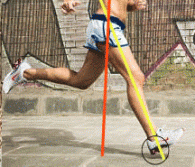|
|
effects of running shoes
Since Nike deputed with the first running shoes in the 1970s, their overall design hasn't changed much. Because they were the first "running shoe" we believe that thats what we need to be running in. The problem with that design is that because of the heel cushioning it forces us to run on our heels. Your foot wants to land on the softest surface and in running shoes that means you're gonna land on your heels.
Categories of today's running shoes
|
|
|
Running shoes cause heel striking
The design flaw in 95% of all running shoes is that they have raised heel cushioning. Raising the heel and putting cushioning under it makes heel striking inevitable. Heel striking is a seriously harmful style of running. When wearing running shoes you consciously have to teach yourself not to heel strike, however when you run with minimalist footwear your body will naturally adapt its stride to run with a midfoot/forefoot strike. The effect in the stride sequence after heel striking is foot "clomping." After landing on your heel the front part of your foot is forcefully pushed toward the ground and upon contact makes a smacking sound, hence "clomping." Clomping sends an additional shock up your leg which is one cause of shin splints. Heel striking also causes excessive overpronation. After heel striking the forces of clomping cause the foot to fall inward and off the side of the big toe. What should be your pushoff phase of your strides ends up being an inward fall off your big toe. |
Problem with heel cushioning (nike air, asics gel, nike boing shox, etc.)
heel cushioning elevates the heels twice as high as the forefoot. 95% of running shoes are built with the 22-12 rule, which means the heel is elevated 22mm (about 1 inch) while the forefoot is elevated 12mm (about 1/2 inch) off the ground. The 22-12 rule is a totally arbitrary number that the original running shoe designers came up with decades ago. A heel elevated to this degree means that it is nearly impossible to not land on your heels.
Only in the last few years have we come to realize the harmful effects of elevating the heel. Which is why brands like Newton and Earth have come up with their solutions. The ideal solution is to go barefoot, but a more practical solution may be to run in minimalist footwear or racing flats.
Only in the last few years have we come to realize the harmful effects of elevating the heel. Which is why brands like Newton and Earth have come up with their solutions. The ideal solution is to go barefoot, but a more practical solution may be to run in minimalist footwear or racing flats.
Danger of Motion Control shoes
Motion Control shoes can cause the most harm and injuries of the three categories of running shoes. Motion Control shoes "correct" and "control" your foot so much that it changes your stride and foot fall. Since your body is not naturally adapted to this new foreign running stride it will put stress on areas of the body that running is not meant to. Motion Control shoes are designed with the stiffest medial posting and the most cushioning. They use a harder density foam under the inner side of your foot. They claim this prevents the foot from rolling inward.
Motion Control shoes can cause the most harm and injuries of the three categories of running shoes. Motion Control shoes "correct" and "control" your foot so much that it changes your stride and foot fall. Since your body is not naturally adapted to this new foreign running stride it will put stress on areas of the body that running is not meant to. Motion Control shoes are designed with the stiffest medial posting and the most cushioning. They use a harder density foam under the inner side of your foot. They claim this prevents the foot from rolling inward.



